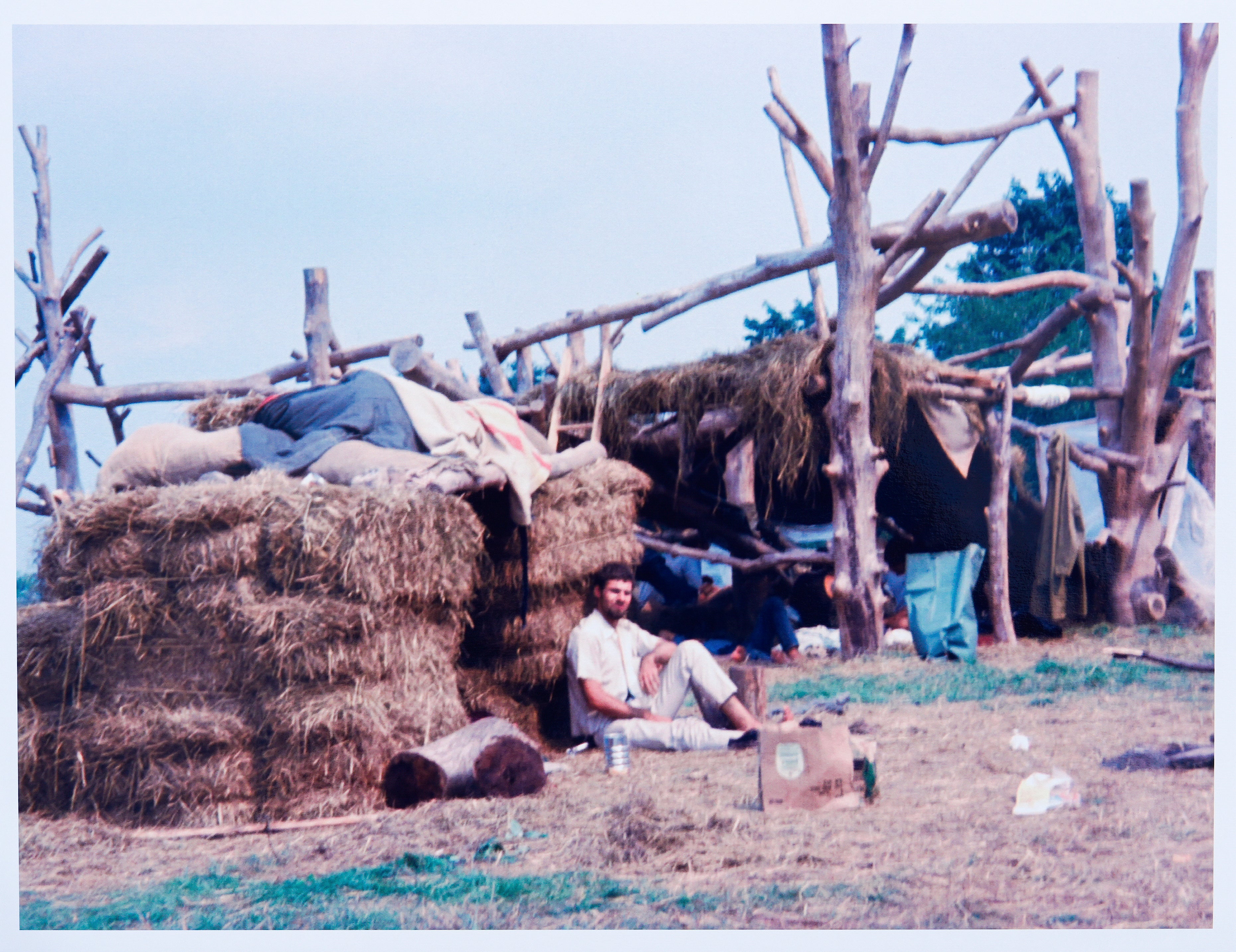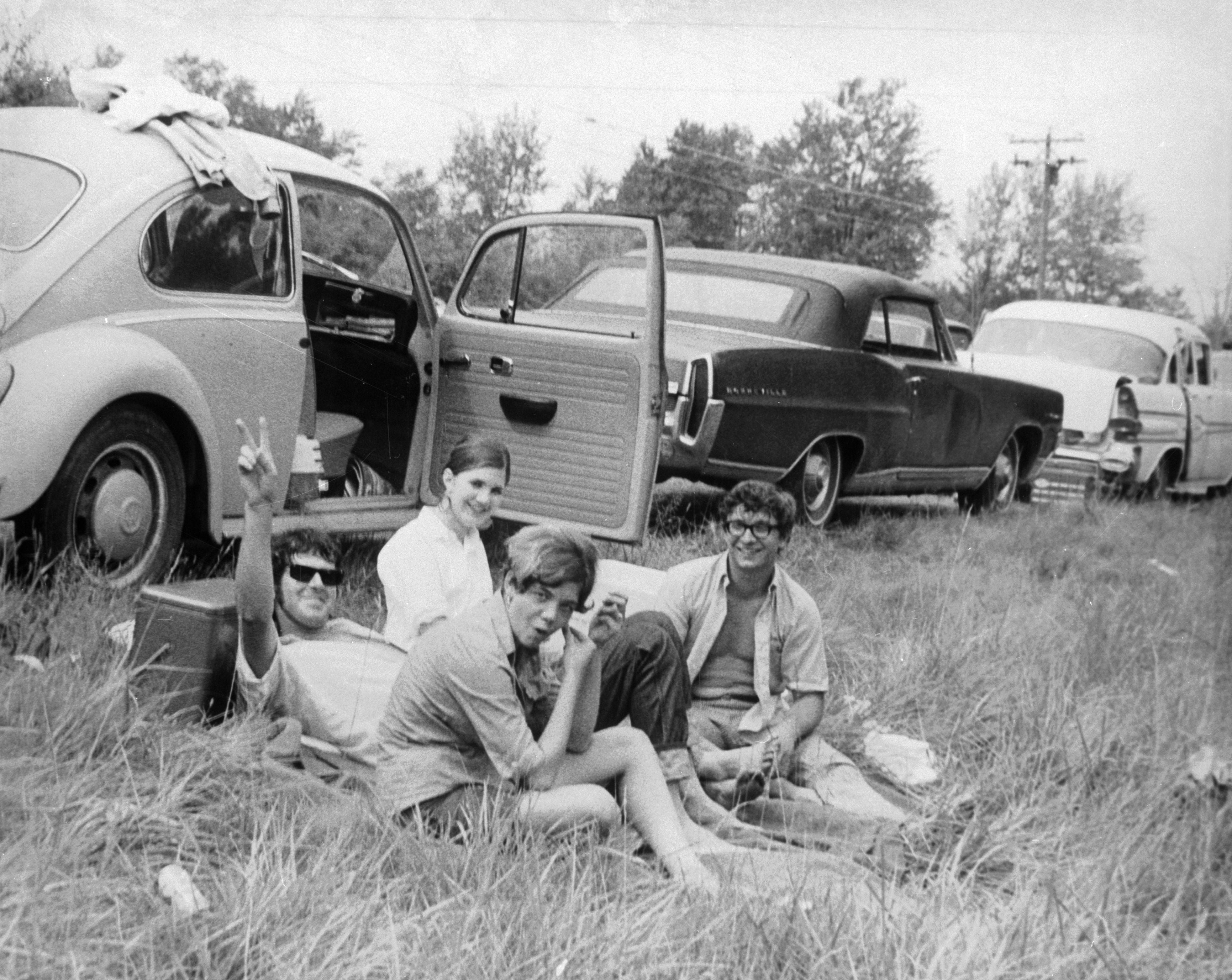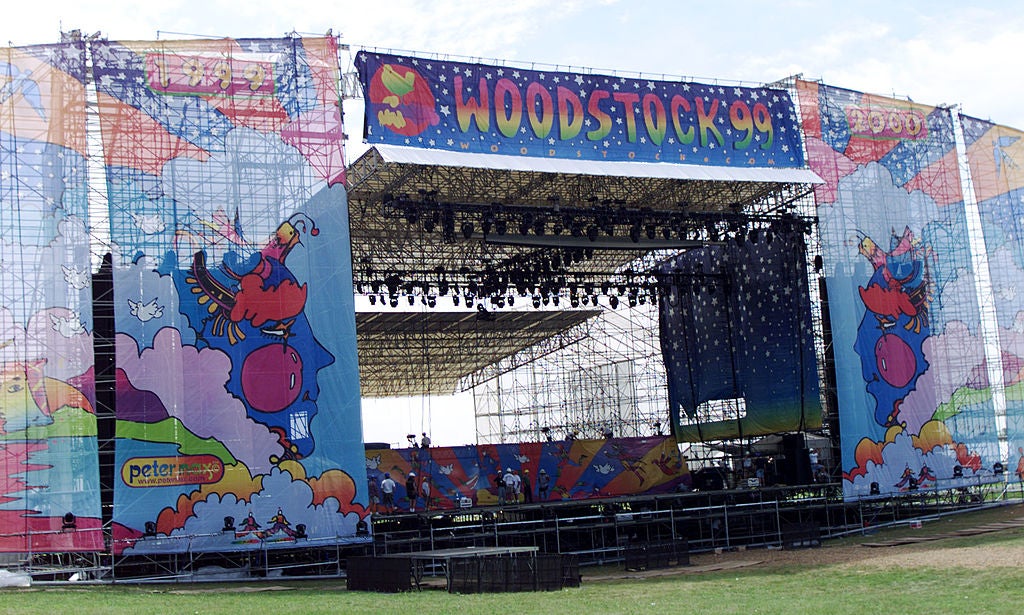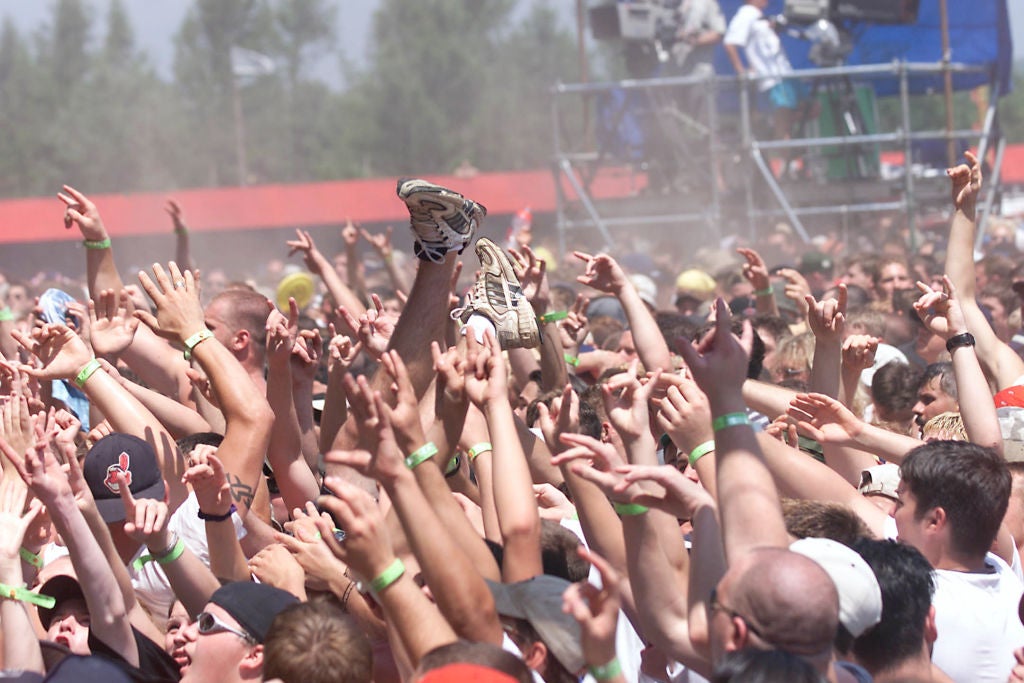In 1969, with flowers in their hair, the children of Woodstock made love, danced naked and braved the elements with a communal spirit of peace and protection. In 1999, with baseball caps on backwards, they attacked audio towers, torched kerosene tankers, looted, rioted and raped.
Whatever happened to the teenage dream? How had the Aquarian utopia of the “three days of peace and music” on a dairy farm in New York 55 years ago this week become, 30 years later at the notorious Woodstock ’99 event, a Lord of the Flies nightmare?
The immediate conditions behind both events are well documented. The 460,000 hippies who tore down the fences on Max Yasgur’s farm at Woodstock ’69 and instigated a state of emergency across Sullivan County endured a weekend of rain, mud and food shortages, all liable to induce a group survival instinct. They swayed late into the night to bands that went well with a hefty spliff – Grateful Dead; Crosby, Stills, Nash and Young; Creedence Clearwater Revival; Joan Baez – many espousing anti-war, pro-love messages from the stage.
The similar number of attendees at the ’99 event, documented in the horrifying 2022 Netflix series Trainwreck and dubbed “Profitstock” by those who were there, faced more rage-inducing conditions. Forty-degree heat on an asphalt air force base with little shade. Vendors scalping them for overpriced food and water. Scarce free water supplies contaminated with human waste. And a line-up dominated by aggressive nu metal and rock acts like Korn, Kid Rock and Limp Bizkit, some literally playing songs called “Fist of Rage” and “Break Stuff”.
But with both events equally chaotic and challenging, there’s clearly far more to a countercultural volte-face as drastic as Russell Brand’s shift in political outlook. What was it that made rebellion in 1969 all about free love and harmony and, in 1999, about blood, lust and destruction?
Much has to do with the growing pains of youth culture itself. In the Sixties, after generations of societal oppression and rigid life expectations, young people were finding their voice through the hippie movement, reacting against a Cold War parental generation that had brought them to the brink of nuclear annihilation with the Cuban missile crisis and engulfed America in the immoral and unnecessary Vietnam war.

“The prevailing mode when you have this highly educated, highly mobile, relatively affluent, very creative younger generation is: ‘why should we look up to you? You’ve done everything wrong, you’ve messed it up’,” says Cambridge University cultural historian James Riley, author of The Bad Trip: Dark Omens, New Worlds and the End of the Sixties.
“Youth found American government, institutions, and the dominant culture incredibly disturbing,” says Damon Bach, a history lecturer at Texas A&M University and author of The American Counterculture: A History of Hippies and Cultural Dissidents. “They revolted against the affluent society, suburbia, repressive sexual culture, and traditional careers and life paths. They sought authenticity and meaningful work, explored Eastern mysticism, and championed sexual liberation and communal living.”

Turned off by the conformity of the picket-fence American dream and the 9 to 5 rat race, the burgeoning counterculture movements springing up in San Francisco’s Haight-Ashbury and elsewhere sought out alternative ways of living – communes, travelling communities and festivals. “Festivals gain pace over the course of the Sixties as momentary, almost temporary experimentations in those alternative ways of being and existing,” says Riley. Hence Woodstock was the counterculture’s ultimate existential test, against the harshest of conditions.
Enjoy unlimited access to 70 million ad-free songs and podcasts with Amazon Music
Sign up now for a 30-day free trial
Enjoy unlimited access to 70 million ad-free songs and podcasts with Amazon Music
Sign up now for a 30-day free trial
And it passed. As the mud rose and supplies ran dry, food was shared and the vendors of the market area Bindy Bazaar began operating a cashless barter system. Riley believes that Michael Wadleigh’s semi-idyllic 1970 Woodstock documentary has rose-tinted our perception of what was also a shambolic, profit-driven and violence-marred event, but sees the hippie ideals in action there.
“Despite the fact that it was quite shambolic, you had small, autonomous temporary communities building up around the swimming areas.” Bach agrees. “Woodstock, for many hippies, represented the supreme moment in counterculture history,” he says. “For three days, hippies immersed themselves in their ideal micro-society … The most ardent hippies viewed Woodstock as a blueprint for a new society.”
Woodstock, for many hippies, represented the supreme moment in counterculture history
Damon Bach
For a while, the establishment, at least outwardly, wasn’t opposed to wearing the odd bit of sky in its hair.
“The Sixties represents a small pocket of left-wing-slash-democratic progressivism, certainly in America, sandwiched between periods of Republican right-wing authority,” says Riley, pointing to a top-down relaxation of laws on censorship, abortion and homosexuality in the UK and the US over the decade. “One has to see the period as a synergy between relatively enlightened policymakers and the receptive youth culture who are ready to go with that.”
But with the Manson murders fresh and Nixon already in the White House, the Sixties spirit was soon broken. “[Nixon’s] administration is defined by its rollback of a lot of that progressivism,” Riley says, and a young, unified and idealistic movement would soon become disaffected, splintered, atomised and redirected. By the second iteration of Woodstock at Winston Farm in Saugerties in 1994, countercultural coherence had been diluted through prog, heavy metal, punk, goth, hardcore, indie rock and grunge, forming an array of divided tribes where once there was a more powerful, politicised force to be reckoned with.
“When you think about the Nineties, it’s very difficult to point to the alternative culture,” says Riley. “There’s a lot of almost siloed interests. We’re metallers over here, we’re moshers over there, we’re goths here, we don’t talk to the other people. We don’t like boy bands, we don’t like dance music, very entrenched cultures.”

Festivals and large stadium shows had also become commonplace rather than generation-defining and a sense of consumerist familiarity bordering on cynicism was creeping into the MTV age. Hence, for all Woodstock ’94’s throwbacks to the original festival – torrential rain, hundreds of thousands of fence-jumpers, chaotic security and organisation, several acts that had performed in ’69 – it felt like a lacklustre attempt to recreate the Summer of Love. A new Woodstock attitude was engendered: acts such as Green Day and Primus were pelted with mud and, during Jackyl’s set early on Friday, singer Jesse James Dupree fired a rifle in the air and chainsawed a burning stool in half.
The true Woodstock spirit, Riley argues, was very much elsewhere. “There was Lollapalooza, there’s things like Ozfest,” he says. “There’s also things like Burning Man festival gaining pace, and the residual 1960s link-up counterculture, that’s where it’s going. That impetus doesn’t really need a Woodstock because it’s finding it elsewhere.”
Meanwhile, the alternative, as it was now known, had been washed through Reagan’s neoliberal rush towards me-me-me capitalism and largely consumed by the same major label corporations that were pushing Billy Ray Cyrus and The Backstreet Boys. “You’re giving your money to the same masters and there’s a lot of almost cognitive dissonance on the part of a lot of groups at the time,” says Riley.
“Nirvana obviously had this, Pearl Jam were wrestling with this, Smashing Pumpkins were wrestling with this – what does that actually mean for their status and is the result of it that they’re just going through a series of poses? If you wanted to analyse what you see at the extent of the [1969 and 1999] Woodstock festivals, it’s people not really knowing what to do and how to behave as a countercultural enclave. You could also just see it as terrible behaviour by entitled people.”

The relative political calm of the era played its part too. “They’re at play at the end of history,” Riley says. “[The Nineties are] this 10 years between the fall of the Berlin Wall and 9/11. I think Douglas Copeland talks about it as this passive, relaxation decade. You’ve got a big signal that a potentially very dangerous conflict has been averted and capitalism has won and that’s fine. And then we’re not yet into the much more dangerous and unknown territory of the 21st century. It’s a moment of respite. What also comes with that is a question about what does rebellion mean?”
Rebellion, it turned out, meant self-gratifying chaos. Woodstock ’99 became a 500,000-capacity tinderbox of music fans who felt they deserved their own generational moment of hedonistic abandon and, when they got an exploitative cash-in instead, responded with primal barbarism. It didn’t help that organiser Michael Lang and his team chose to lash the festival’s permissive ideology to the most aggressive edge of alternative culture.
“Woodstock ’94 feels much more like an attempt to create some kind of dialogue with Woodstock ’69,” Riley says. “There’s some of the same performers there, there’s some of the same styles. Woodstock ’99 feels like a completely different festival. It’s effectively nu metal with a couple of other chart toppers popped in. Nirvana used to moan about people in Guns N’ Roses T-shirts turning up to the concerts, jocks and stuff turning up to the concerts, like they had any way to actually police that. But when you get to Woodstock ’99, that’s almost a large-scale elaboration of that.”
It seems unthinkable that Lang went on to plan a 50th anniversary Woodstock in 2019 with The Killers, Jay-Z and Miley Cyrus on the bill, an event that was eventually cancelled following permit issues, funding drop-outs, venue downsizing and artist withdrawals. The Woodstock name, after all, had already been resoundingly trashed. A shame, too, at a time when our Woodstock ’99 sort of world badly needs a Woodstock ’69 sort of ethos.

